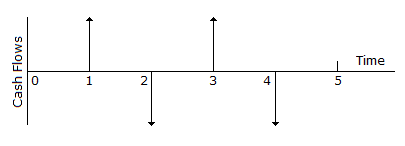Civil Engineering :: Engineering Economy
-
A project construction cost estimate includes:
-
In the cash flow diagram shown in the given figure

-
Pick up the correct statement from the following:
-
The person desires to pay off the amount in 10 equal annual instalments. The amount of each instalment is :
-
Renu Bala deposits Rs 1200 now, Rs 800 two years from now and Rs 1000 five years from now. If the savings bank's rate of interest in 5%, she will receive an amount of Rs X 10 years from now, where X is
-
Pick up the correct statement from the following:
-
Pick up the correct statement from the following:
-
Keeping in view, the feasibility order of magnitude, the preliminary, conceptual or budget estimates, are prepared by :
-
The construction manager uses the estimate of the project
-
If P is principal amount, i is the rate of interest per annum and n is the number of periods in years, the compound amount factor (CAF) is :
|
A.
The receipts and disbursements in a given time interval are referred to as cash flow.
|
|
B.
The assumptions that all cash flows occur at the end of the interest period, is known as the end of period convention.
|
|
C.
A cash flow diagram is a graphical representation of cash flows drawn on a time scale.
|
|
D.
The cash flow diagram represents the statement of the problem and also includes what is given and what is to be found.
|
|
E.
All of the above.
|
|
A.
The capital required to get a project started is the first cost.
|
|
B.
The first cost is a single cash flow or a series of cash flows that are made in the beginning of the activity's life span
|
|
C.
The first cost of purchasing a car is the sum of the down payment, taxes and dealers charges.
|
|
D.
All of these
|
|
A.
Engineering economy is a collection of mathematical techniques which simplify economic comparisons
|
|
B.
Engineering economy is a decision assistance tool by which one method will be chosen as the most economically one.
|
|
C.
For understanding the engineering economy, one should be able to classify the basic terminology and fundamental concepts of economy.
|
|
D.
All of these.
|


 Whatsapp
Whatsapp
 Facebook
Facebook

